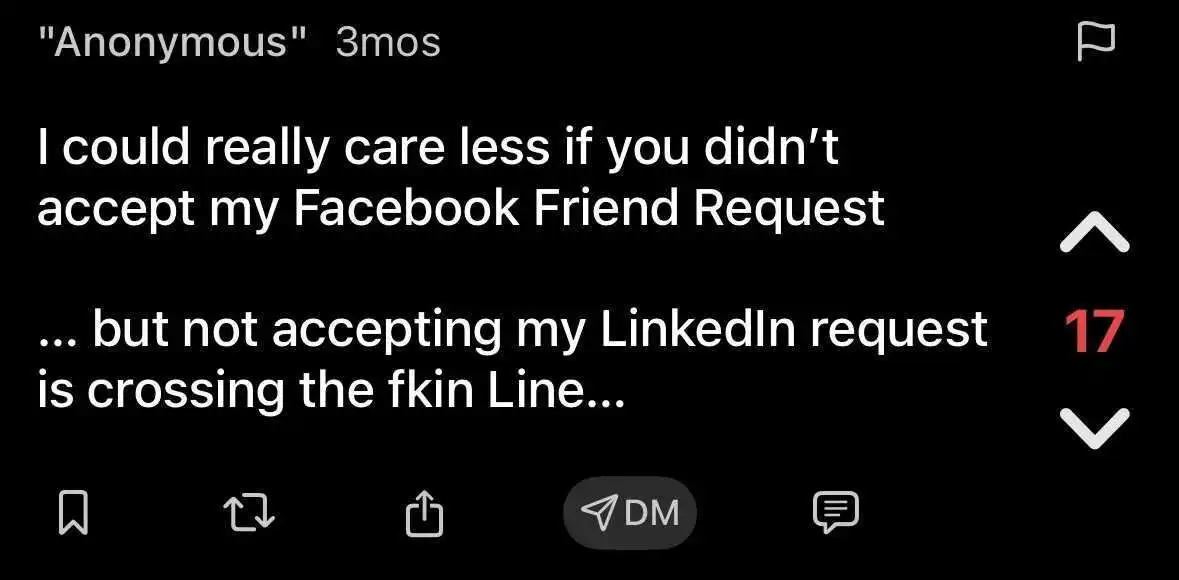In “Chronically Online,” columnist Chloe Shannon Wong ’28 spotlights Stanford students immersed in the world of the Internet.
According to LinkedIn, one young innovator from San Jose is among People Magazine’s 100 Reasons to Love America. She’s an Afore Capital intern, a former researcher at MIT and once presented her code to Apple CEO Tim Cook. She directed the largest hackathon for girls on the West Coast, advised state legislation and founded a tech startup called SIREN — for which she not only developed a novel school safety device, but also garnered $50,000 in funding.
It’s the type of resume you’d expect from an accomplished, mid-career entrepreneur. And Rebecca Wang ’28 hasn’t even finished her first quarter of university.
Wang’s profile is just a taste of what you’ll find on LinkedIn — the world’s largest professional networking website. LinkedIn enables more than 900 million users to find career inspiration, describe past experience and connect with industry experts, job recruiters and peers. Anyone can join LinkedIn (and that means anyone).
Former president Barack Obama is on LinkedIn. So are high school freshmen. According to Sunny Xun Liu, director of research at the Stanford Social Media Lab, LinkedIn culture runs strong at the Farm.
“Most [Stanford students] have very clean profiles,” Liu said. “They spend a lot of time maintaining those profiles.” With some 300,000 students and alumni on the platform, perhaps you’ve heard these words at a club meeting or career fair: What’s your LinkedIn? We should totally connect!
Even online, memes poke fun at the platform’s popularity, while revealing the weight LinkedIn holds in Stanford students’ lives as a form of social media.
“I could really care less if you didn’t accept my Facebook friend request,” reads one anonymous Stanford Fizz post from July 2024. “but not accepting my LinkedIn request is crossing the f—ng line.”

On misconceptions
Liu said LinkedIn culture isn’t exclusive to Stanford, but it is shaped by Stanford-specific factors — namely, the school’s close ties to Silicon Valley and the resulting pressure to succeed career-wise.
This proximity has both benefits and downsides. Before freshmen even understand college, Liu said they “must understand [Silicon Valley] as well.”
Wang, for one, skillfully describes herself as a “CS and MS&E student at Stanford with an interest in startups, venture capital and entrepreneurship.” Wang also knows to separate her personal life from her professional one, after joining LinkedIn in ninth grade to increase exposure for her hackathon.
Though she hasn’t found many opportunities directly via LinkedIn, Wang considers the platform a good way to stay updated. But when she catches up with people, she won’t bring work into the conversation, nor does she make a habit of looking people up on LinkedIn.
“I’m not much of a ‘Oh, let’s compare each other!’ [person],” Wang said. “I dislike that type of culture.”
In her experience, imposter syndrome — the notion that one’s accomplishments are unearned — is a big part of LinkedIn culture. It’s a feeling many at Stanford are familiar with, and leads to students questioning whether they belong.
“Everybody [at Stanford], they’re all amazing, but they do feel pressure,” Liu said. LinkedIn can exacerbate that type of insecurity. When we look at high-achieving people, we connect them to our expectations for ourselves.
“So if you think about that, LinkedIn is just a reflection of people’s expectations and anxieties and efforts,” Liu said.
Wang doesn’t feel she’s strongly affected by LinkedIn’s imposter culture, noting that she joined the platform young and has familiarity with it. Nonetheless, she still prefers face-to-face interaction: LinkedIn isn’t a reflection of her true personality, she said. In the past, the app has actually fostered inaccurate perceptions of her character.
“People would look at my LinkedIn profile before meeting me and [be] like, ‘Oh, she’s probably somebody who’s super serious about life and doesn’t have much of a personality,’” Wang said. “‘[She’s] a hundred percent, ultra-focused on work.’”
But once people get to know her outside the straitlaced environment of LinkedIn, “they find I have a really funny, social personality that they would not have expected,” she said.
On being in the know
According to Jesus Ballesteros ’25, two things happen on LinkedIn: either people apply to jobs, or they apply to jobs while flaunting their accomplishments. Ballesteros worked at LinkedIn as a software engineering intern this past summer. While he said he loves the platform and considers it a valuable tool, he also doesn’t think that being chronically on LinkedIn is “a good thing for anyone.”
“The culture of users on LinkedIn can be slightly toxic,” Ballesteros said. “The algorithm is kind of built to push out as much engaging content as possible, which usually tends to be people at the peak of their careers.”
As a senior, Ballesteros doesn’t feel LinkedIn has much presence in his daily life. But as a freshman, it was common for students to “stalk,” or intensely follow, each other’s LinkedIn profiles.
LinkedIn stalking is normal, Liu said. As humans, we want to understand what’s happening around us; that curiosity extends to other people’s activity. Looking at LinkedIn profiles is a natural form of information surveillance. But excessive stalking can also worsen self-comparison, making Stanford students feel like they’ll never catch up to their peers.
Ballesteros expressed a similar sentiment, noting that “[LinkedIn] is a way that people come to realize that they’re a small fish in a big pond again.”
But at the same time, LinkedIn provides a necessary glimpse into Stanford’s environment while fostering professional equity. As a first-generation immigrant from a low-income background, Ballesteros said “LinkedIn has played a huge role in my early career.”
Ballesteros discovered a Liberty Mutual Insurance internship through LinkedIn. More recently, a Meta recruiter found him on the platform — and now he’s been offered a job in software engineering.
Nonetheless, he refrains from treating LinkedIn as more than an extended resume.
“There [are] a lot of people who look great on paper,” Ballesteros said. “But if you get to know them, and you really get to see what kind of people they are … sometimes, they’re not so great. And sometimes, they become your lifelong best friend.”
On making connections
Like Wang and Ballesteros, Machmud Makhmudov J.D. ’25 has a formidable resume. He’s a Knight-Hennessy and Rhodes Scholar, researched a ghostwritten book for Vice President Kamala Harris during her Senate days and will graduate from Stanford Law School in the spring.
Makhmudov created a LinkedIn account in college, but wasn’t particularly active until his political work required him to start recruiting.
“I knew I needed to find a way to get outside of my bubble,” Makhmudov said.
The advantage of LinkedIn, he said, is that its algorithm gives a platform to critical topics like voter protection. Promotion of those issues — rather than his own accomplishments — is the main priority.
But in the past, even Makhmudov has experienced his share of self-comparison.
“You see people becoming more senior [in the workplace] as a result of not taking time off to go to school like I did,” Makhmudov said. “That can sometimes feel like, ‘Oh, I’m behind.’” But over the years, that sentiment has eased, he said.
“I’m doing what’s right for me, and that’s very different from anyone else,” he added. “So the comparison point isn’t as relevant.”
In contrast to social media like Instagram, Makhmudov is less casual about what he posts on LinkedIn since he’s connected to “a bunch of old people.” He considers LinkedIn a good mechanism for finding opportunities and setting up interviews. While he was once skittish about reaching out, he’s learned that “people like to help young people,” he said
Like Ballesteros, Makhmudov’s background influenced his perspective on LinkedIn. Makhmudov was born in Uzbekistan and grew up in Atlanta. For Makmudov, LinkedIn is a way to engage with a broader — even global — audience.
“There’s not a lot of people from [Uzbekistan] that go to Stanford, or do some things I’ve done,” Makhmudov said. Without LinkedIn, “I would have no means of knowing who they are. And they wouldn’t be able to get to me.”
That goal of interpersonal connection is evident from Makhmudov’s activity on LinkedIn, which include reposts of an event focused on the empowerment of Spanish-speaking voters, advice panels and motivational messages.
“Bet on yourself and dream big,” Makhmudov wrote in a LinkedIn post addressing law school applicants from underrepresented backgrounds. And to people like himself, who have made it to institutions like Stanford, he writes, “I hope you can find some time to spread the gospel of showing others that they can and should believe in themselves to dream big too.”
Listed alongside Makhmudov’s many diplomas, scholarships and job positions on LinkedIn are two words: Grateful Immigrant.
On the balance
LinkedIn can be many things: a diary of accomplishments, a global socio-political space, a launchpad for a lifelong career. While LinkedIn can be a wide indicator of what people care about, Liu said it doesn’t always provide answers to essential human questions: Is this an authentic person? A good person? Someone I want to spend time with?
These questions can only be answered through genuine interaction — taking a class with someone, going to a party, she said.
Social media rarely depicts life in its full richness. We pick our personas; choose which events to document; cultivate certain aesthetics. LinkedIn won’t tell you about Ballesteros’ taste in memes, Makhmudov’s movie nights with friends or Wang’s lighthearted nature. And, most of the time, LinkedIn also won’t tell you about failure, Liu said.
“Stanford students sacrifice a lot to build their LinkedIn profiles,” Liu said. “But you don’t see how many internships [students applied to]. You only see the ones that they got accepted to.”
Liu said Stanford students should be proud of their accomplishments. But in a sense, LinkedIn is just like any other social media — users tend to highlight the positives while hiding the negatives.
In the end, should young people even be on LinkedIn?
The “best and real answer” can only come from young people themselves, Liu said. Students should evaluate their specific motivations for joining the platform. Who is my target audience on LinkedIn? What do I hope to achieve? Am I genuinely building my career, or simply following the crowd?
LinkedIn is valuable to college students, and understandably so. But “self care is important,” Liu said. “Sleep is important.” Maintaining one’s LinkedIn is a time commitment. For a graduate student with clear goals in mind, LinkedIn may be a worthwhile professional endeavor. But for eager freshmen still finding their footing, the stress it incurs may not be worth it.
There are two questions Liu suggests students should ask themselves before entering the world of LinkedIn, given its manifold social and psychological implications.
The first: Am I ready?
And the second: What’s the trade-off?
